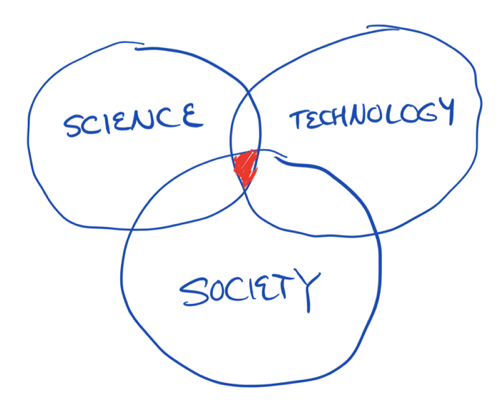A Venn diagram is a diagram that shows all elements of multiple sets drawn as circles, including elements common to multiple sets (i.e. regions of overlapping circles). If you were to draw a Venn Diagram of science, technology, and society, what would you say is in the intersection? In other words, if you look at those aspects of the science discipline that also overlap with technology, and that also overlap society — culture, humanity, politics — what do you get?
I doubt you’ll find a concise answer.
In fact, one might only be able to attempt the start of a cogent response only after assuming some particular viewpoint. For example, one might look at the intersection of science, technology, and society from the viewpoint of the history of science — an entire discipline all to itself. Similarly, one might change vantage points, or your pair of glasses, for the disciplines of philosophy of science or sociology of science. And of course, don’t forget to answer from the viewpoints of the history of, philosophy of, and sociology of technology.
But getting a better understanding of that intersection is becoming increasingly important to, well, everyone, as technology plays an increasingly more important role in our lives, for example, with the Internet of Things, and as our understanding of science keeps us alive (for example, with advances in medicine) and keeps our planet alive (for example, through a better understanding of climate change). Yet we also have (non-technical and non-scientific) politicians who recklessly imperil the world by eschewing science and technology guidance in fits of post-truth1 tantrums. And the scientists and technologists themselves also play a role, as often they miss the impact of their work on society as a whole whilst chasing theories, grants, and inventions. For example, after learning of the atomic bomb falling on Hiroshima, Albert Einstein said, “Woe is me.”2
In fact, an entire new discipline has been created to better understand this intersection, unsurprisingly called “Science, Technology, and Society,” or STS. This is a new field, and all matters have not yet coalesced — for example, some instead refer to the field as “Science and Technology Studies,” though helpfully (or confusingly) the acronym is the same.
According to Steve Fuller (p. 1)3:
Science and Technology Studies (STS) is an interdisciplinary field usually defined as the confluence of three fields with distinct intellectual lineages and orientations: history of science, philosophy of science, and sociology of science.
Of course, that was an early attempt at defining the field — note the lack of “technology” — and the emphasis and participation of the sub-fields “history of,” “philosophy of,” and “sociology of” are not exactly equal.
Again perhaps mis-emphasizing “science”, David Hess (p. 1)4 suggests,
Science studies provides a conceptual tool kit for thinking about technical expertise in more sophisticated ways. Science studies tracks the history of disciplines, the dynamics of science as a social institution, and the philosophical basis for scientific knowledge. It teaches, for example, that there are ways of developing sound criteria for evaluating opposing theories and interpretations, but also that there are ways of finding the agendas sometimes hidden behind a rhetoric of objectivity. In the process, science studies makes it easier for laypeople to question the authority of experts and their claims. It teaches how to look for biases, and it holds out a vision of greater public participation in technical policy issues.
Finally, just to add one more vantage point to the nebulous and evolving understanding of what is the definition and purpose of the field, Sergio Sismondo (p. 13)5 says,
STS looks to how the things it studies are constructed.
So, I hope at least it has been made clear here that this intersection of science, technology, and society is a thing, and it’s in fact a very important — vital! — thing to better understand. This intersection directly impacts our lives and shapes our future. Thus, it is reasonable to suggest that this intersection is rather worth looking at more closely — something I’ll actually be doing henceforth, starting with this essay, so stick around and join the adventure.
-
“Word of the Year 2016 is…”, https://en.oxforddictionaries.com/word-of-the-year/word-of-the-year–2016 ↩︎
-
“Know Einstein”, http://www.newyorker.com/magazine/2002/11/25/know-einstein ↩︎
-
Fuller, S. (2007). New frontiers in science and technology studies, Polity. ↩︎
-
Hess, D. J. (1997). Science studies: An advanced introduction, NYU press. ↩︎
-
Sismondo, S. (2008). “Science and technology studies and an engaged program.” The handbook of science and technology studies 3: 13–32. ↩︎
